|
 Laccaria lilacina Laccaria lilacina
BiostatusPresent in region - Indigenous. Endemic
Images (click to enlarge)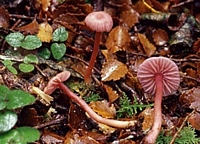
Caption: Laccaria lilacina
Owner: Kaimai Bush | 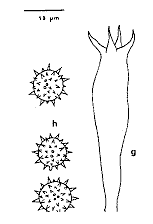
Caption: L. lilacina: i, basidium; j, spores. |  | 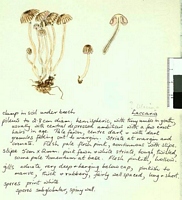
Caption: Watercolour
Owner: G.M. Taylor | 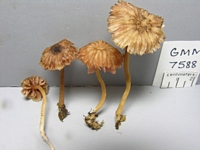
Caption: Laccaria lilacina?: 7588: see photo
Owner: Greg Mueller | 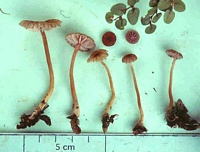
Owner: Karl Soop | 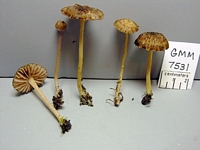
Caption: Laccaria lilacina: 7531: PILEUS: 5-35 mm diam, broadly convex. Umbonate when young then depressed, appressed fibrillose when young then scaley, undulate, ground color dull vinaceous to tan, scales dark brown to black. LAMELLAE: adnexed, distant, relativ
Owner: Greg Mueller | 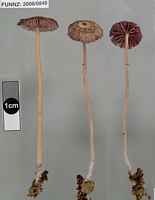
Caption: FUNNZ: 2006/0849, See public note for more information
Owner: FUNNZ | |
Article: McNabb, R.F.R. (1972). The Tricholomataceae of New Zealand. 1. Laccaria Berk. & Br. New Zealand Journal of Botany 10(3): 461-484 (http://www.rsnz.org/publish/abstracts.php).
Description: PILEUS: 2-5.5 cm diam., strongly convex when young,
plano-convex, applanate, or centrally depressed with reflexed margins at maturity,
often radially split, hygrophanous, non-viscid, sometimes radially sulcate almost
to centre, finely radially fibrillose when young, fibrils cracking to form numerous,
minute squamules and scales giving pileus a scurfy appearance at maturity, background
colour buff, fibrils, scales, and squamules dark brown to brownish black. Cuticle
composed of unspecialised, repent, subparallel, thin-walled, clamped hyphae
7-10 µm diam. with dark brown contents near surface of pileus and often aggregated
into clumps. LAMELLAE: adnate, distant, intermixed, thick, to 5 mm deep, pallid
violaceous when young, turning buff with age, glaucous. STIPE: 5-10 cm long,
± equal or tapering apically, 3-5 mm diam., tough, dry, hollow, longitudinally
fibrillose-striate, dull pallid fawn to buff, paling basally; flesh concolorous
with exterior.
SPORES: spore print not obtained; spores globose
to subglobose, apiculate, hyaline, inamyloid, moderately echinulate, 8.5-11
µm diam. including spines, spines to 1.2-(1.8) µm long. HYMENIUM: basidia hyaline,
clavate, 35-50 X 8-11 µm, 4-spored, sterigmata to 9 µm long; paraphyses sparse,
simple, inconspicuous, HYMENOPHORAL TRAMA: regular, composed of tinted, parallel-interwoven,
long-celled hyphae; clamp connections present. CONTEXT OF PILEUS: pallid fawn.
SMELL AND TASTE: unknown. CHEMICAL CHARACTERS: unknown.
Habitat: Gregarious or caespitose under Nothofagus.
Notes: Laccaria lilacina is characterised by the closely and minutely squamulose pileus of mature
fructifications, pallid violaceous lamellae, and longitudinally fibrillose-striate
stipe. Young fructifications resemble those of L. fibrillosa, but at
maturity the fine radiating fibrils on the pileus of L. lilacina become
cracked into minute squamules, whereas in L. fibrillosa the dark coloured
fibrils remain unaltered. In addition, spores of L. lilacina are smaller
with shorter spines. The species is restricted to southern beech forests.
Article: Stevenson, G. (1964). The Agaricales of New Zealand: V. Kew Bulletin 19(1): 1-59.
Description:
Pileus 4-5.5 cm diam. fawn, covered with dry fulvous fibrils, which
crack into very small scales, convex to plane with upturned edge, which is
often split; flesh thin, pale fulvous. Gills adnate, distant, lilac, and mealy.
Stipe 10 cm x 3-4 mm dull fawn whitish at base, solid or hollow, subfibrous,
silky striate. Spores 7-8 µm diam., spines 0.5-1 µm long, non-amyloid,
thick-walled (Fig. 4); print white.
Habitat: Under Nothofagus, Pinehaven, 13.7.1947, A. P. Druce; Butterfly,
26.6.1948, J. McCan, Silverstream, 27.7.1948) L. B. Moore, Woodside, 1.7.1953)
M. Morrison in Stevenson (type).
Notes: The European L. amethystina is more generally purple coloured and
has larger spores with longer spines than this species, which is however close
to it.
|